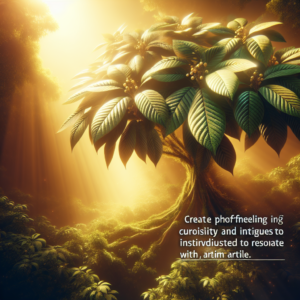Understanding Kratom: An Overview
Kratom, scientifically known as Mitragyna speciosa, has gained popularity in recent years. This natural herb originates from Southeast Asia and has been used for centuries due to its various effects. Users often describe Kratom as a stimulant at lower doses and a sedative at higher doses. These unique properties have made it a topic of conversation in wellness circles.
At its core, Kratom interacts with the body’s opioid receptors. This interaction can alter how you experience pain, mood, and even anxiety. But with such a powerful influence on the brain and body, it’s natural to ponder the connection between Kratom and mood swings. Understanding this connection requires a closer look at both Kratom’s effects and mood regulation.
How Kratom Works in the Body
Kratom leaves contain several active compounds, primarily mitragynine and 7-hydroxymitragynine. When consumed, these compounds attach to opioid receptors in the brain. This connection can produce both stimulating and sedative effects, depending on the dose.
At lower doses, Kratom typically boosts energy levels and enhances focus. Users often report feeling uplifted, more sociable, and less anxious. However, as the dose increases, the effects shift toward relaxation and sedation, which may lead to a sense of calm. Understanding these effects is vital when considering Kratom for mood regulation.
The Role of Opioid Receptors
Opioid receptors play an essential role in how your body processes pain and emotions. Specifically, mu, delta, and kappa receptors are the main types involved in mood and emotional responses. When Kratom binds to these receptors, it can create feelings of euphoria, relaxation, or even sedation.
Interestingly, the effects can vary widely among individuals. Factors such as body chemistry, tolerance, and even mood prior to consumption can all impact your experience with Kratom. These individual differences contribute to the diverse range of responses, from improved mood to sudden mood swings.
Mood Swings: An Overview
Mood swings refer to rapid and extreme fluctuations in a person’s emotional state. These ups and downs can occur for a variety of reasons. External factors, psychological conditions, and hormonal changes all contribute to mood instability. Understanding why mood swings happen can help in addressing them effectively.
Many experience mood swings due to stress, anxiety, or fatigue. Life events, whether positive or negative, can also affect one’s emotional state. It’s essential to approach mood swings with sensitivity and understanding, as they can significantly impact daily life and relationships.
The Importance of Mood Regulation
Regulating mood is crucial for maintaining overall mental health. Unstable moods can lead to difficulties in personal relationships, work performance, and self-esteem. Recognizing the signs of mood swings is the first step in addressing them. Common signs include:
- Irritability
- Sudden anger
- Sadness
- Euphoria
When left unaddressed, these swings can become more frequent and severe. Turning to natural remedies like Kratom may seem promising, but it’s essential to consider both the benefits and risks involved.
Kratom and Mood Regulation
Kratom has the potential to help regulate mood for some users. Those looking to enhance their emotional stability might see some benefits from its use. However, it’s important to remember that everyone’s body reacts differently. Some may find relief from anxiety, while others might experience heightened emotional swings.
The Potential Benefits
- Anxiety Relief: Many users report a reduction in anxiety levels when using Kratom.
- Elevated Mood: Lower doses often lead to feelings of euphoria and enhanced sociability, helping to combat feelings of sadness.
- Stress Reduction: Users may find that Kratom helps alleviate stress, making it easier to cope with everyday challenges.
While these benefits sound appealing, they come with their own concerns. Higher doses may lead to sedation, which can cause drowsiness and impair daily functioning. Finding the right dosage is crucial for positive outcomes.
The Risks of Kratom Use
Despite its potential advantages, Kratom is not without risks. Overuse can result in dependency, tolerance, or withdrawal symptoms. Furthermore, some users may experience side effects like:
- Nausea
- Constipation
- Mood swings
These risks highlight the importance of using Kratom responsibly. Always consult with a healthcare professional before incorporating it into your routine, especially if you have pre-existing mood disorders.
The Science Behind Kratom and Mood Swings
Scientific research on Kratom is still limited, but some studies offer insights into its influence on mood. Certain compounds in Kratom may have antidepressant-like effects. However, much of the evidence is anecdotal.
Chemical Interactions
The primary alkaloids in Kratom interact with various neurotransmitters. For example, mitragynine can boost serotonin and dopamine levels, improving mood and promoting feelings of happiness. However, this connection can lead to fluctuations. If users suddenly stop taking Kratom, they may experience withdrawal symptoms that can trigger mood swings.
Individual Response Variability
Each person reacts differently to Kratom based on genetics, previous substance use, and mental health history. For some, Kratom may be a positive addition to their wellness routine. For others, it may exacerbate mood swings or lead to dependency.
Kratom in Different Forms and Their Impact on Mood
Kratom comes in various forms, including powders, capsules, and teas. The method of consumption can impact its effects as well.
Kratom Powders
Kratom powder is the most common form. Users can mix it with beverages or take it directly. This method allows for flexible dosing but can also lead to variations in effects.
Kratom Capsules
Capsules offer a convenient way to consume Kratom without the earthy taste. However, they may take longer to affect mood because they must dissolve in your digestive system first.
Kratom Tea
Making tea from Kratom leaves is another popular method. This preparation can provide a smoother experience. Users often report gradual effects, making it easier to gauge mood changes.
Dosage Matters: Finding the Right Amount for You
When considering Kratom for mood stabilization, dosage is crucial. Finding the right amount can determine whether you experience positive effects or unpleasant side effects.
Recommended Dosages
- Low Dose (1-5 grams): Potentially uplifting and energizing.
- Moderate Dose (5-15 grams): Balancing both energizing and sedative effects.
- High Dose (15-30 grams): More sedative and relaxing, but risks side effects.
Start with a lower dose to assess how your body reacts. Gradually increase if needed, and always be mindful of how it affects your mood.
User Experiences: Anecdotal Evidence
Many users have shared their personal experiences with Kratom and mood regulation. While individual stories vary widely, common themes often emerge.
Positive Testimonials
Some users describe feeling less anxious and more at peace. They report that Kratom has helped them engage more socially and enjoy life’s simpler moments. These uplifting experiences contribute to the herb’s growing popularity in wellness communities.
Cautionary Tales
Conversely, some have found that Kratom exacerbates their mood swings. Users who already struggle with anxiety or depression might find the effects unpredictable. This inconsistency underscores the importance of self-awareness and responsible use.
Legal and Ethical Considerations Surrounding Kratom
As Kratom gains traction, legal and ethical issues arise. While many states permit its use, others have enacted bans. Understanding the legal landscape can help you make informed choices.
Current Legal Status
In the United States, Kratom’s legality varies by state. Some states have fully legalized it, while others have restrictions or outright bans. Always check your local regulations before purchasing or using Kratom.
Ongoing Research and Future Directions
As researchers explore more about Kratom, its benefits and risks continue to be studied. The potential for mood regulation remains a key area of interest. Ongoing research will clarify which aspects of Kratom are most effective for mood stabilization.
FAQs About Kratom and Mood Swings
1. Can Kratom help with anxiety?
Yes, many users report that Kratom alleviates anxiety symptoms. However, individual reactions can vary.
2. What are the side effects of Kratom?
Common side effects include nausea, constipation, and mood swings, particularly at higher doses.
3. How long does it take for Kratom to work?
The onset varies based on the form consumed. Powders usually take 30-60 minutes, while capsules may take longer.
4. Is Kratom safe for long-term use?
Long-term use can lead to dependency and withdrawal symptoms. It’s best to use it responsibly.
5. Can I mix Kratom with other substances?
Mixing substances can be risky. It’s advisable to consult a healthcare professional before combining Kratom with anything else.
6. What dosage is best for mood improvement?
Start with a low dose of about 1-5 grams and adjust based on how your body reacts.
7. Can Kratom cause mood swings?
Yes, some users experience mood swings, especially if they develop a tolerance or stop using it abruptly.
8. Is Kratom addictive?
There is potential for addiction, particularly with long-term use. Caution is essential.
9. How do I choose the right Kratom strain for mood stabilization?
Different strains produce different effects. Research the specific strain’s properties and consult user experiences.
10. Is there scientific evidence to support Kratom’s effects on mood?
Research is still limited, but anecdotal evidence and some studies suggest potential mood-stabilizing properties.
Conclusion
The relationship between Kratom and mood swings invites further attention. While many experience potential benefits, others face challenges with its use. Always approach Kratom mindfully and consider consulting a healthcare professional. Understanding your body’s unique responses to this herb can guide you in making informed choices.
As the conversation surrounding Kratom continues to grow, staying informed will empower you to navigate its complexities in your quest for emotional balance.







